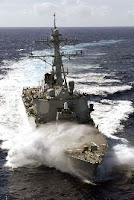This article is very touching and heartwarming. It is amazing how many different opportunities there really are in our Marine Corp! This is just one such remarkable story. I can only imagine there are so many more...please take a moment and pay some attention to our younger Marines.
North Bend, Ore. native Inspires Marines with Art.
20 Jul 07
By Sgt. Andy Hurt
13th MEU
NEAR KARMAH, Iraq (July 18, 2007) – On a blistering hot day here in the Al Anbar province, Marines not conducting patrols seek solace in shade and machine-cooled air, books, video games and word finds. It’s highly unlikely to find a Marine outdoors unless he has to be. One of those Marines is Lance Cpl. Cory Howland. A gunner for Kilo Company, 3rd Battalion, 1st Marines, Howland is working on something special. His latest masterpiece is a table-top drawing of a comically voluptuous she-devil, complete with horns, tail and menacing eyes. It’s huge, and perfect. Although Howland has spent the last two days here scratching away at the table with a map pen, wiping dust from his eyes after every pen stroke, he wouldn’t rather be doing anything else. Howland is a company artist.

The drawing is Howland’s submission in an art competition. The Marines of Kilo Company recently moved to Combat Outpost Lincoln and have worked around the clock to make the base livable. Filling hundreds of sandbags and erecting camouflaged netting in uncovered areas have been the main tasks, and now the finishing touches are being added. For the completion of the table, set between two company tents, Howland was pitted against a fellow company artist, Lance Cpl. Michael Morgan. Although there isn’t a prize, the reward, says Howland, is completion.
“I could care less what people think. When I’m done, I love looking back and saying ‘I made this.’”
Roots.
Howland hails from the Great Pacific Northwest. Bedded along Oregon’s rocky pine-peppered coast lies North Bend, pop. 10,000, Howland’s home town. It’s the kind of place, Howland says, where “everybody knows your name.”
“North Bend is the one place I’ve always known where everyone is nice and always in a good mood … you feel comfortable walking down the street.”
From the age of twelve, Howland has been drawing – everywhere on everything. He’s never without a pencil and paper. North Bend High School was the perfect place for a young artist to branch out.
“In high school, I took an art class every term,” he said. “I did everything, from painting to molding jars of clay.”
His true love of drawing, however, was apparent to his instructors, and Howland says they gave him free reign, whatever the period of instruction was.
“After a while, my teachers realized that I loved to draw, so I really didn’t have to do what the rest of the class was doing. They’d just let me chill out and draw.”
The relaxed atmosphere, combined with raw talent produced excellent results. When Howland was a sophomore, his work was added to a permanent installation at a local museum. Howland says the accomplishment has been his proudest moment.
“It’s still there,” he said, “Just a simple drawing of a vase and a flower.”
Another of his favorite pieces is a twelve-inch clay figurine of “Jack the Pumpkin King” from the movie The Nightmare Before Christmas. Howland said the sculpture, which took him the better part of three months to complete, was a tribute to his instructor who worked as an animator on the film.
“I’m pretty sure it’s still at the school.”
While producing his art, Howland says he was all-along considering service in the military. After careful deliberation, he whittled his future down to two options – art school, or the Marine Corps. The final decision came from, what else – a televised omen.
“I remember sitting on the couch, watching TV, and a commercial came on for an art institute. I asked myself ‘should I pursue an art career, or the Marine Corps? And no kidding, the next commercial that came on was the Marine Corps commercial – the one where the guy is climbing – and I pretty much made up my mind then.”
Honor, Courage, Commitment … and tattoos.
Howland said when he came in the Marine Corps, one of his biggest fears was losing his drawing skills. The hustle-and-flow of Marine Corps life has made personal time a commodity.
“There’s just no time to draw,” he said. “I’m always training or working on my weapon system or something … I worry that I’ll lose my skills. This isn’t like riding a bike you know.”
Luckily, Howland has found plenty of time. Recognized in recruit training for his abilities, Howland was selected as an “Artist Recruit”, tasked with creating motivating range flags and other projects. During his time at the School of Infantry, Howland drew countless tattoos for young Marines, all the while filling sketch pads with personal work and sending them back home for storage. He says he used proceeds from his tattoo commissions to buy more materials.
Company Artist.
In Iraq now, doing his countries dirty work, Howland continues to create and inspire. His time is divided between patrols, guard duty and “COP Beautification (filling sandbags).” Howland’s unit, the “Thundering Third” Battalion, 1st Marines, serves as the ground combat element for the 13th Marine Expeditionary Unit. Setting sail this spring, the unit traveled aboard Navy ships, stopping for liberty calls in Guam and Singapore prior to landing in Kuwait. Since mid-June, Howland’s brothers in Kilo Company have dwelled in the arid Iraqi deserts, conducting 24-hour counter-insurgency operations. Life is dismal and dreary at times, frequent sand storms and scorching heat make for tedious off-hours. Still, Howland practices his passion. He’s even drawn on goat skulls.
When Kilo Company moved from the relatively pleasant Combat Outpost Pacers – seated on the shores of Lake Thar Thar – to the apocalyptic ruins of COP Lincoln, the Marines did whatever they could to add comfort here. Constantly looking for opportune motivation, Howland’s seniors looked at a blank piece of plywood and saw a canvas.
“Howland’s a good kid,” said Staff Sgt. Michael Bate, Howland’s platoon sergeant. “When he came to us from security forces, he didn’t really know anyone, and his drawing has been a great way to get to know everybody.”
Bate, a native of Philadelphia, says although the subject matter of the massive drawings could be considered taboo, the Marines aren’t trying to exploit anyone. Drawings of women were popular on World War II airplanes, and often serve as momentary inspiration for troops marching into battle. At COP Lincoln, pictures of beautiful women were also the most available subject matter.
“They just grabbed a magazine they had, and the squad leaders picked out two pictures. They’re focusing on the art, and it’s a contest. The subject matter makes for added difficulty … shading legs and the detail of the hair and everything.”
Bate added that for anyone to negatively criticize the drawings would be openly insulting Howland’s work ethic.
“Howland stayed up all night working on the drawing, and when the Marines woke up this morning, they had something nice to look at. He sacrificed his sleep for the morale and welfare of his fellow Marines.”
Howland is still out there, adding careful shadows to contours and shapes. Painstakingly filling in “negative space” so the she-devil’s hair looks incredibly real. He’s working under critical eyes, and Led Zepplin tunes blast from tiny speakers nearby.
“Is that the girl from the magazine,” asks one Marine.
“Yes, sergeant,” says Howland. Another Marine walks by and smiles.
“If she was Satan, I wouldn’t mind going to hell.”
What’s ironic is that Howland, as he draws this sensual demon-girl, is in heaven.
Photo - Lance Cpl. Cory Howland, a squad automatic weapon gunner with 1st squad, 2nd platoon, Kilo Company, adds details to his recent “devil girl” drawing on a company table. Kilo Company and 3rd Battalion, 1st Marines have been conducting counter-insurgency operations in the Al Anbar province here. Photo by Sgt. Andy Hurt.
Sources:
www.Marines.mil.
This was originally posted @
DoD Daily News-2.

















































